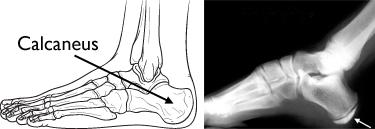Sever's disease is one of most common causes of heel pain in children, and often occurs during adolescence when children hit a growth spurt. Also known as an osteochondrosis or apophysitis, Sever's disease is an inflammatory condition of the growth plate in the heel bone (calcaneus). Running, jumping, and being active lead to repetitive stress on the growth plate as the foot strikes the ground. This results in inflammation (swelling) in the growth plate which causes heel pain.
The primary treatment of Sever's disease is to rest the foot (stop the sport) until the pain goes away. Frequently, the Achilles tendon is contracted and stretching is necessary to prevent recurrence of pain. Once the pain is gone, the child may return to normal activities.
Additional treatments may include:
- Heel pads. Heel cushions inserted in sports shoes can help absorb impact and relieve stress on the heel and ankle.
- Activity Modification and Immobilization. Rest from excessive running/jumping activities for a variable duration of time is recommended and use of a walking boot or cast may be necessary.
- Stretching exercises. Stretches for the Achilles tendon (heel cord) can reduce stress on the heel.
- Non-steroidal anti-inflammatory medication. Medications like ibuprofen (Motrin/Advil) and naproxen (Aleve) reduce pain and swelling.
In cases where the pain is bad enough to interfere with walking, a short-leg cast or "walker boot" might be required to immobilize the foot while it heals.
It is not unusual for Sever's disease to recur for several reasons. With growth, the Achilles tendon can become tight once again. Premature or rapid return to sports and excessive running/jumping sports are also cause for recurrence. Wearing sports shoes that provide good support to the foot and heel may help prevent recurrence. Sever's disease will not return once a child is fully grown and the growth plate in the heel has hardened into bone.

The illustration on the left shows normal skeletal anatomy of the adult foot. On the right, an x-ray of an adolescent foot shows the open growth plate of the calcaneus. It is not possible for a doctor to diagnose Sever's disease only by reviewing an x-ray, as the x-ray appearance looks similar for those with apophysitis and those without any symptoms.
